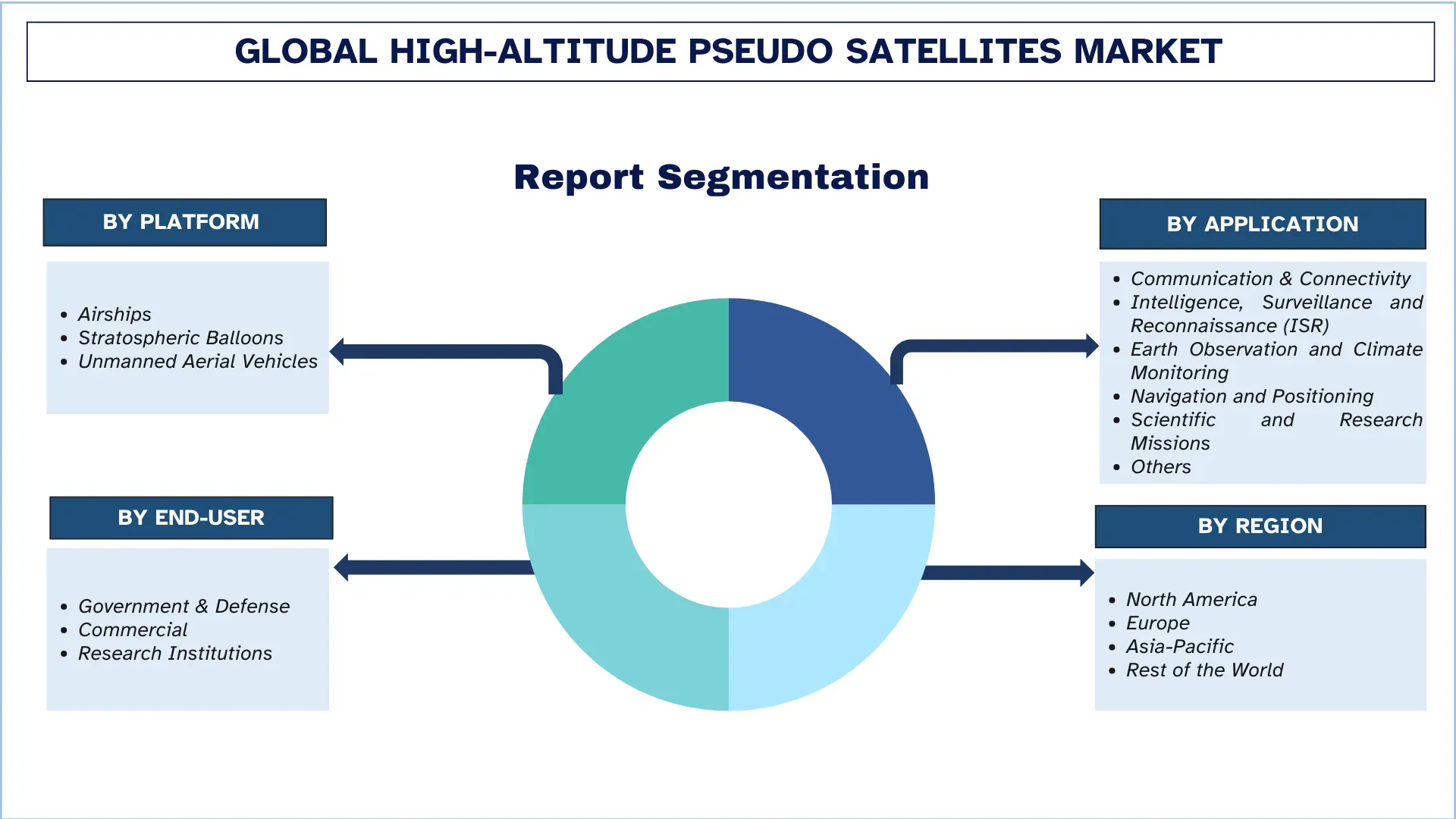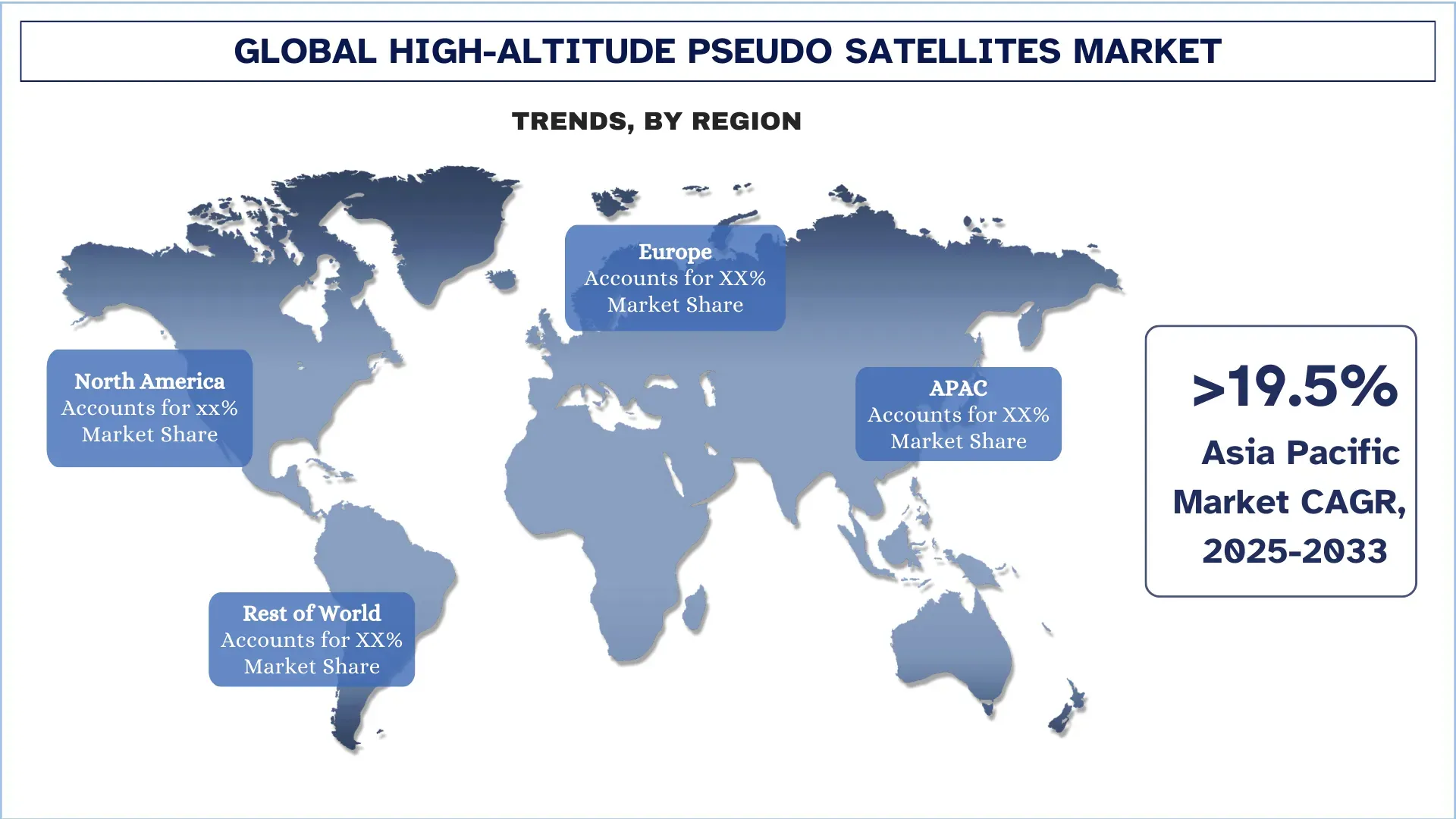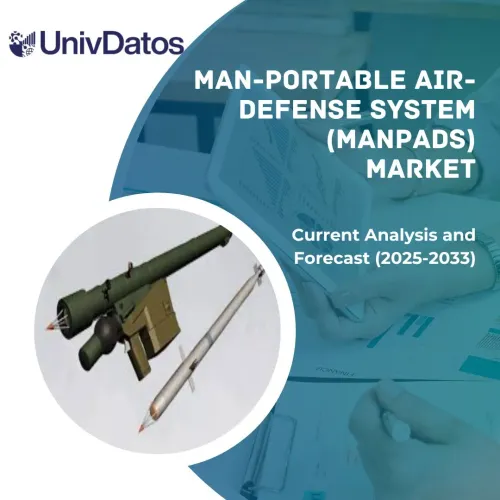- Home
- About Us
- Industry
- Services
- Reading
- Contact Us
High-Altitude Pseudo Satellites Market: Current Analysis and Forecast (2025-2033)
Emphasis on Platform (Airships, Stratospheric Balloons, and Unmanned Aerial Vehicles); Application (Communication and Connectivity, Intelligence, Surveillance and Reconnaissance (ISR), Earth Observation and Climate Monitoring, Navigation and Positioning, Scientific and Research Missions, and Others); End-User (Government & Defense, Commercial, and Research Institutions); and Region/Country

Global High-Altitude Pseudo Satellites Market Size & Forecast
The Global High-Altitude Pseudo-Satellite Market was valued at USD 92.66 million in 2024 and is expected to grow at a strong CAGR of around 18.12% during the forecast period (2025-2033F), driven by the growing demand for low-cost, high-speed connectivity in remote and underserved regions.
High-Altitude Pseudo Satellites Market Analysis
The high-altitude pseudo-satellite (HAPS) is a telecommunication platform located in the stratosphere at an altitude of 20 km. HAPS, or "flying base stations," provide communication services from aircraft that stay in the stratosphere, where winds are relatively calm throughout the year. It enables direct communication with mobile devices like the smartphones we use daily, and its closer proximity to the ground compared to GEO and LEO satellites allows for low-latency communication.
The HAPS market is expected to continue to grow because of various major factors. High demand for low-cost broadband connectivity in remote areas is encouraging telecom operators and the government to use HAPS as an alternative to traditional satellites. Moreover, the growing number of HAPS defense and military applications is further increasing the adoption of HAPS systems.
Global High-Altitude Pseudo Satellites Market Trends
This section discusses the key market trends that are influencing the various segments of the global High-altitude Pseudo Satellites market, as found by our team of research experts.
Growing focus on sustainability and green aviation technologies
One of the potential future trends of the global high-altitude pseudo-satellites (HAPS) market is the increased attention to sustainability and green aviation technologies. With growing concerns about the environment, various industry players are using solar-powered systems and lightweight composite materials, as well as energy-efficient designs to minimize carbon emissions and enhance stability. HAPS platforms, unlike traditional aircraft and satellites, have the advantage that they can last months and have a low environmental impact, so they are supported by both governments and commercial operators. This trend is in line with the worldwide efforts to foster clean energy and environmentally friendly aerospace solutions, and this makes sustainable HAPS technologies an important catalyst in future growth and adoption of the HAPS markets across the globe.
High-Altitude Pseudo Satellites Industry Segmentation
This section provides an analysis of the key trends in each segment of the global high-altitude pseudo-satellite market report, along with forecasts at the global, regional, and country levels for 2025-2033.
The Stratospheric Balloons Segment Dominates the Global High-Altitude Pseudo-Satellites Market
Based on the platform category, the market is categorized into airships, stratospheric balloons, and unmanned aerial vehicles. Among these, the stratospheric balloons segment currently holds the maximum market share in the HAPS market because it is cheap, easy to install, and has been used in communication, environmental monitoring, and scientific research. However, the fastest growth is anticipated to occur in the unmanned aerial vehicles (UAVs) segment in the future due to developments in solar-powered technology, long endurance, and its accurate station-keeping features. HAPS based on UAVs are a growing trend in telecom, defense, and Earth observation, making them the driving force of market development.
For instance, in July 2023, BAE Systems’ PHASA-35, a solar-electric High-Altitude Pseudo-Satellite (HAPS) UAV, successfully completed its first stratospheric test flight (a 24-hour journey reaching over 66,000 feet before landing safely). This milestone underscores its potential for long-endurance roles in surveillance, communications (4G/5G), and disaster-relief operations, working above weather and air traffic constraints.
The Communication and Connectivity Segment Dominates the Global High-Altitude Pseudo Satellites Market.
Based on the application category, the market is categorized into communication and connectivity, intelligence, surveillance and reconnaissance (ISR), earth observation and climate monitoring, navigation and positioning, scientific and research missions, and others. Among these, the communication and connectivity segment currently holds the maximum market share in the high-altitude pseudo-satellite market. Telecommunication operators and governments are currently implementing HAPS to offer low-cost and high-speed broadband services to remote and underserved areas as an alternative to satellite and ground-based networks. This has increased its demand in the market. However, in the future, the intelligence, surveillance, and reconnaissance (ISR) segment has the highest potential growth, with the growing geopolitical tensions worldwide.

North America holds the largest market share in the global High-Altitude Pseudo Satellites market
North America is considered to have the biggest market share in the global high-altitude pseudo-satellite (HAPS) market because of its rich technological base, huge military expenditure, and the adoption of modern aerospace systems. The region has major manufacturers of HAPS, including AeroVironment, Aurora Flight Sciences (Boeing), and World View Enterprises, that provide innovations and massive deployment. Major investments by the U.S. Department of Defense and NASA in intelligence, surveillance, reconnaissance (ISR), and scientific research also support the market. Additionally, the growing demand for establishing telecom connectivity and environmental surveillance in remote locations is ensuring the dominance of the North America HAPS market.
The United States held a Dominant share of the North America High-Altitude Pseudo Satellites Market in 2024
The USA dominates the North America high-altitude pseudo-satellite (HAPS) market in 2024 due to the early use of advanced aerospace technologies, large investments in R&D, and robust defense priorities. The country has an established aerospace supply chain and the involvement of the major participants who are working on solar-powered UAVs, stratospheric balloons, and hybrid airships. Massive government programs, especially the military surveillance, border security, and strategic communication systems, have enhanced deployments. Also, the partnerships of the federal agencies with the private companies, coupled with the interest of the country in the development of broadband services in the rural areas, made the USA a leader in the regional HAPS market.

High-Altitude Pseudo Satellites Industry Competitive Landscape
The global high-altitude pseudo-satellite market is competitive, with several global and international market players. The key players are adopting different growth strategies to enhance their market presence, such as partnerships, agreements, collaborations, geographical expansions, and mergers and acquisitions.
Top High-altitude Pseudo Satellites Market Companies
Some of the major players in the market include AeroVironment, Inc., Airbus SE, Prismatic (BAE Systems), SoftBank Corp., World View Enterprises, Inc., Kea Aerospace, Aurora Flight Sciences (The Boeing Company), Maraal Aerospace Pvt Ltd., Thales Group, and Avealto.
Recent Developments in the High-Altitude Pseudo Satellites Market
In May 2025, the Indian Air Force (IAF) announced that it had ordered three HAPS platforms to enhance surveillance capabilities, particularly in border security and urban monitoring. This move aligns with India's broader defense modernization efforts and the increasing demand for stratospheric coverage in both military and civilian applications.
In September 2025, SoftBank Corp. conducted a successful field trial on Hachijō Island, Tokyo, demonstrating end-to-end 5G communications from a stratospheric platform. This trial utilized a newly developed 6-cell capable HAPS payload, integrating service and feeder link equipment to deliver stable connectivity across a 200 km² area.
Global High-Altitude Pseudo Satellites Market Report Coverage
Report Attribute | Details |
Base year | 2024 |
Forecast period | 2025-2033 |
Growth momentum | Accelerate at a CAGR of 18.12% |
Market size 2024 | USD 92.66 million |
Regional analysis | North America, Europe, APAC, Rest of the World |
Major contributing region | The Asia-Pacific region is expected to dominate the market during the forecast period. |
Key countries covered | U.S., Canada, Germany, U.K., Spain, Italy, France, China, Japan, and India. |
Companies profiled | AeroVironment, Inc., Airbus SE, Prismatic (BAE Systems), SoftBank Corp., World View Enterprises, Inc., Kea Aerospace, Aurora Flight Sciences (The Boeing Company), Maraal Aerospace Pvt Ltd., Thales Group, and Avealto. |
Report Scope | Market Trends, Drivers, and Restraints; Revenue Estimation and Forecast; Segmentation Analysis; Demand and Supply Side Analysis; Competitive Landscape; Company Profiling |
Segments Covered | By Platform, By Application, By End-User, and By Region/Country |
Reasons to Buy the High-Altitude Pseudo Satellites Market Report:
The study includes market sizing and forecasting analysis confirmed by authenticated key industry experts.
The report briefly reviews overall industry performance at a glance.
The report covers an in-depth analysis of prominent industry peers, primarily focusing on key business financials, type portfolios, expansion strategies, and recent developments.
Detailed examination of drivers, restraints, key trends, and opportunities prevailing in the industry.
The study comprehensively covers the market across different segments.
Deep dive regional level analysis of the industry.
Customization Options:
The global High-altitude Pseudo Satellites market can further be customized as per the requirements or any other market segment. Besides this, UnivDatos understands that you may have your own business needs; hence, feel free to contact us to get a report that completely suits your requirements.
Table of Content
Research Methodology for the Global High-Altitude Pseudo Satellites Market Analysis (2023-2033)
We analyzed the historical market, estimated the current market, and forecasted the future market of the global high-altitude pseudo-satellite market to assess its application in major regions worldwide. We conducted exhaustive secondary research to gather historical market data and estimate the current market size. To validate these insights, we carefully reviewed numerous findings and assumptions. Additionally, we conducted in-depth primary interviews with industry experts across the high-altitude pseudo-satellite value chain. After validating market figures through these interviews, we used both top-down and bottom-up approaches to forecast the overall market size. We then employed market breakdown and data triangulation methods to estimate and analyze the market size of industry segments and sub-segments.
Market Engineering
We employed the data triangulation technique to finalize the overall market estimation and derive precise statistical numbers for each segment and sub-segment of the global high-altitude pseudo-satellite market. We split the data into several segments and sub-segments by analyzing various parameters and trends, including platform, application, end-user, and regions within the global high-altitude pseudo-satellite market.
The Main Objective of the Global High-Altitude Pseudo Satellites Market Study
The study identifies current and future trends in the global high-altitude pseudo-satellite market, providing strategic insights for investors. It highlights regional market attractiveness, enabling industry participants to tap into untapped markets and gain a first-mover advantage. Other quantitative goals of the studies include:
Market Size Analysis: Assess the current and forecast market size of the global high-altitude pseudo-satellites market and its segments in terms of value (USD).
High-Altitude Pseudo Satellites Market Segmentation: Segments in the study include areas of platform, application, end-user, and region.
Regulatory Framework & Value Chain Analysis: Examine the regulatory framework, value chain, customer behavior, and competitive landscape of the high-altitude pseudo-satellite
Regional Analysis: Conduct a detailed regional analysis for key areas such as Asia Pacific, Europe, North America, and the Rest of the World.
Company Profiles & Growth Strategies: Company profiles of the high-altitude pseudo-satellite market and the growth strategies adopted by the market players to sustain the fast-growing market.
Frequently Asked Questions FAQs
Q1: What is the global high-altitude pseudo-satellite market’s current market size and growth potential?
As of 2024, the global high-altitude pseudo-satellite (HAPS) market is valued at USD 92.66 million and is projected to grow at a CAGR of 18.12% between 2025 and 2033, reflecting strong demand for stratospheric communication, surveillance, and environmental monitoring solutions.
Q2: Which segment has the largest share of the global high-altitude pseudo-satellite market by platform category?
The stratospheric balloons segment currently dominates the global high-altitude pseudo-satellite market due to its low cost, ease of deployment, and long-duration capabilities for communication and research applications.
Q3: What are the driving factors for the growth of the global high-altitude pseudo-satellite market?
Top growth drivers of the high-altitude pseudo-satellite market include:
• Rising demand for low-cost connectivity in remote areas.
• Increasing use in military and defense surveillance applications.
• Growing adoption for environmental monitoring and scientific research.
Q4: What are the emerging technologies and trends in the global high-altitude pseudo-satellite market?
Emerging trends in the high-altitude pseudo-satellite market include:
• Miniaturization of payloads for lighter, more efficient platforms.
• A growing emphasis on sustainable and green aviation technologies to reduce environmental impact.
Q5: What are the key challenges in the global high-altitude pseudo-satellite market?
Key challenges in the high-altitude pseudo-satellite market include:
• Regulatory hurdles and complex airspace management requirements.
• High research, development, and manufacturing costs for advanced HAPS platforms.
Q6: Which region dominates the global high-altitude pseudo-satellite market?
North America dominates the global high-altitude pseudo-satellite market, driven by strong government and defense investments, technological expertise, and the presence of leading HAPS manufacturers.
Q7: Who are the key competitors in the global high-altitude pseudo-satellite market?
Top players in the high-altitude pseudo-satellite industry include:
• AeroVironment, Inc.
• Airbus SE
• Prismatic (BAE Systems)
• SoftBank Corp.
• World View Enterprises, Inc.
• Kea Aerospace
• Aurora Flight Sciences (The Boeing Company)
• Maraal Aerospace Pvt Ltd.
• Thales Group
• Avealto
Q8: What are the key investment opportunities in the global high-altitude pseudo-satellite market?
The high-altitude pseudo-satellite market offers significant investment opportunities in fixed-wing UAVs, stratospheric balloons, and emerging airship platforms. Growth areas include telecom connectivity for remote regions, defense surveillance solutions, and environmental monitoring services, particularly in Asia-Pacific and North America, where government support and technological adoption are accelerating market expansion.
Q9: Which applications and end-use sectors are expected to drive demand in the high-altitude pseudo-satellite market?
The primary applications driving market demand are communication and connectivity, intelligence, surveillance, and reconnaissance (ISR), Earth observation, climate monitoring, and navigation services. Major end-users include government and defense agencies, commercial telecom operators, and research institutions, with increasing adoption for remote broadband coverage and environmental data collection.
Related Reports
Customers who bought this item also bought










